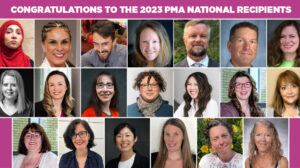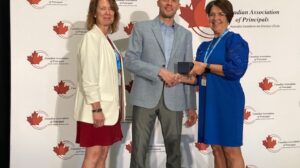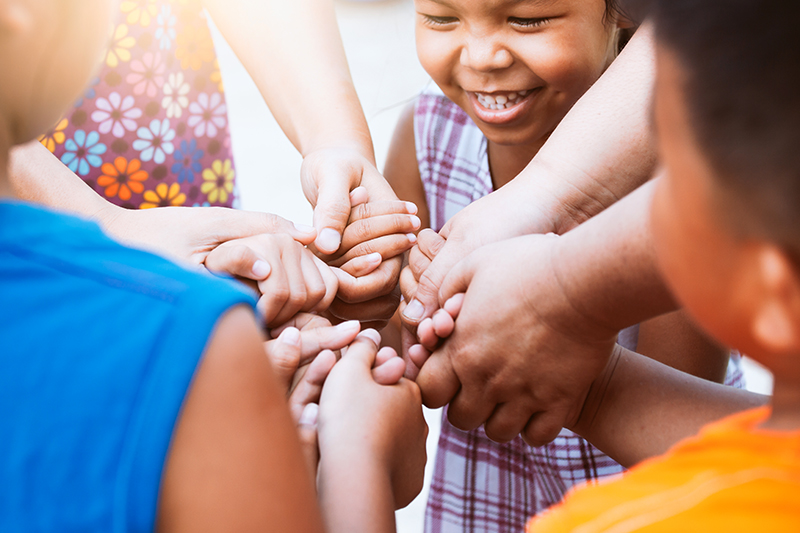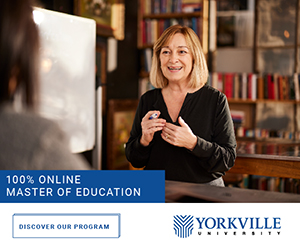Common sense tells us that inclusion initiatives cannot thrive in environments where people are disconnected, have little sense of belonging and are struggling with their well-being. In the school year ahead, principals are tasked with creating healthy and supportive environments where all stakeholders including teachers, students, staff, families can thrive – all at a time when we are still recovering from the erosion of the social fabric in our schools and communities.
The reality we are all accepting is we are not going back to “normal” anytime soon. Further, the complex issues in our systems cannot be remedied with quick fixes; and, on a school level, principals are not able to tackle such formidable issues using traditional approaches alone. The struggles of the past two years have led to notable increases in everything from mental health issues to bullying and hate crimes – a spectrum of symptoms with seemingly related root causes. These indications are no doubt a result of the unprecedented levels of uncertainty, prolonged interruptions to interpersonal interaction, diminished opportunities for extra-curricular activities, an absence of routine and ritual, and the subsequent loss of a sense of purpose, meaningful connection, and engagement for young people.
However, one of the gifts of the past two years has been the collective interest in taking a closer look at what is at the heart of inclusion and belonging. In order to provide schools with foundational support for critical conversations around inclusion, we need to examine the subtle interplay between well-being and identity, and how they contribute to feeling a sense of inclusion and belonging. Since launching Captains & Poets in schools in 2019 we have seen time and again that they are inextricably intertwined.
Dr. Helen Street, honorary associate professor in the graduate school of education at The University of Western Australia and chair of Positive Schools has introduced the concept of Contextual Wellbeing: “a state of health, a happiness and positive engagement in learning that arises from membership of an equitable, inclusive and cohesive school environment. (2016) In her book Contextual Wellbeing – Creating Positive Schools from the Inside Out, she highlights the relationship between the individual and the environment. “Rather than, ‘How can we improve the wellbeing of young people in our schools?’ perhaps we should be asking, ‘How can we improve equity, creativity and cohesion?’” (2018)
The challenge of creating more inclusive schools is we cannot promote inclusion without first addressing the fundamental human need of connection. This includes connection to self, connection to others, and connection to the world around us. We need to acknowledge that everyone has universal needs of physical, mental, and emotional safety that need to be met before we can connect. We also need to recognize where our systems and behaviours are in direct opposition to the very norms we are trying to reinforce.
Well-being does not happen in a vacuum. It is largely a social experience as well-being and connection have a reciprocal relationship. When we are positively engaged in an environment, we are more likely to have a healthy sense of well-being. Likewise, when we are feeling supported around our well-being, we are more likely to participate in positive ways. One supports and reinforces the other.
When we put a well-being lens on current school priorities around Diversity, Equity and Inclusion (DEI), we can begin to understand the challenges we face in making progress on our objectives. The changes we are trying to make in schools to support a more inclusive environment are directly impacted by the collective state of well-being and vice versa. Both students and educators are struggling with mental health issues in unprecedented ways and most principals will tell you that resilience and well-being is at an all-time low. We need to provide a safe space to explore these needs first. Our individual needs being met are then, in turn, closely mirrored in our collective sense of well-being. Street goes further to stress the importance of context when looking at well-being. Sometimes well-being is about expressing negative emotions and identifying what is not working for us. More than ever, we need to create conditions for this to happen in schools.
A similar interplay is seen in the development of a healthy sense of identity. Identity is a result of the complex and ongoing dynamic between what is in inside of us yearning to be expressed, what opportunities and/or barriers are present in our environment, how we present ourselves in the world, and how the world responds to us. At any given point in our lives, we are both solo agents and co-creators in every social interaction. We can see this demonstrated in how we shift our orientation to identity in different contexts (work, home, the community, etc.) based on the roles we play, our own needs, motivations and aspirations, the expectations of us, the environment and the underlying needs and dynamics of the group.
It becomes increasingly clear that the development of identity and well-being are not entirely separate constructs. Case in point, the rise of trauma-informed approaches illuminates the interplay between lived experience, our sense of identity in the world, our general well-being, and our ability to express ourselves fully and healthily in different social contexts. It follows that inclusion initiatives should not be mutually exclusive from those of well-being. Otherwise, we are presenting principals with an insurmountable challenge of tackling complex issues through a compartmentalized lens. What is needed more than ever is an integrated approach; and the fact is we are all wired for it.
According to Dr. Dan Siegel, a clinical professor of psychiatry at the UCLA School of Medicine and the Executive Director of the Mindsight Institute, interpersonal neurobiology frames the mind as both embodied and relational. It includes what happens in the whole-body experience as well as how we interact with people and more broadly our world. Siegel’s research demonstrates that well-being comes from a state of ‘integration’ whereby we create harmony of our parts within us and extend this relationally by respecting this process in others. With this mindful lens, we can become aware of our experiences and honour where we are at to achieve harmony within first. At once we tap into the ability to acquire insight into oneself and have empathy for others. We can be attuned to differences and at the same time ‘link’ to them with compassion. Well-being can then be described as an integrated self or way of being in the world which leads to the ability to form deep relationships that create space for vulnerability and inspire connection, caring and the desire to help others. Is this not the formula for inclusion?
Looking through this integrated lens, we can begin to understand why taking a purely educational approach to critical DEI conversations is limited. We engage advocacy groups to deliver workshops and keynotes to illuminate the lived experiences of others and inspire us to open our minds to create greater understanding. We resonate with their stories, and we leave inspired only for our institutions to go back to business as usual on Monday. What we aren’t tapping into is the sense of connection that is surfaced in those moments. Without the ability to sustain this connection, our efforts wane and our impact erodes. Until the next year when the cycle repeats.
DEI initiatives aren’t just a top-down initiative and certainly should not be a box-ticking exercise, especially with limited resources and energy on hand right now. Perhaps what we have been missing all along is that the desire for connection is a free and abundant resource at our disposal. We need to make a shift from informational approaches to inclusion to transformational ones that anchor in our hearts and weave into how we engage each day. Building and then sustaining this bridge between self and others is where we fail. The reality is inclusiveness begins on an individual level. As a result, it is essential we find ways to address and engage those in the room, their own perceived sense of identity and their readiness to connect.
True connection begins from a place of moment-to-moment awareness where we hone and develop who we are in the world, while simultaneously transforming the relationships around us. We can all reap the benefits of living more authentically and cultivating greater connection by leveraging a deeper, broader sense of self in everything we do. At the heart of inclusion initiatives is fostering connection to self while honouring a sense of connection across our differences. The first step we need to take is toward ourselves.
The emergence of self-awareness in human development is both a curse and a gift. It yields the curse of self-consciousness, which inhibits us from being who we are in the moment. But it gives the gift of self-leadership, which empowers us to make choices about who we want to be in the world and to live into our potential. We all remember those first moments in our young life when we suddenly became self-conscious. We received a subtle or not so subtle cue from our environment that there were aspects of ourselves that weren’t valued or didn’t belong. In that moment, we became fragmented. Our well-being AND our identity were directly impacted. Take a minute to reflect on those defining moments for yourself and who you would be if you had instead received the message that all parts of you matter and are worthy of being seen. How did those defining moments impact who you became in that moment and your happiness over the long-term?
We spend our lives on a journey back to wholeness to reclaim ourselves. We yearn for environments that allow us to find comfort in our own skin and encourage us to be our best, fullest selves. In education, we talk about this in terms of enabling students to reach their full potential, but this is often diminished to academic and strengths-based approaches. What gets missed is the whole child – who we are in all our complexity – as well as how our surrounding social contexts impact us on an individual level. Street reminds us in her book that:
’Flourishing’ is an interplay between our best individual selves and our best environment. This means happiness and success are far more than individual pursuits, or even individual responsibilities. Rather, lasting happiness develops when we form healthy connections in a social context that supports and nurtures us to become the best we can be.
When young people are given opportunities to explore and express who they are and to pursue what is important to them in a safe environment, it results in a healthy sense of identity AND well-being. As educators, we need to be mindful of our responses to students and what messages we are sending about who they are, how much they matter, and what is valued or not valued in them. There are many ways in which we tell students not to bring their full selves. We ask them to get along and when they don’t fit in or retreat from the group we move on with the business of the day. We ask them to conform to the rules and when they step outside these lines, we exclude them. Our systems and behaviours are often contradictory to the very inclusive norms we are trying to reinforce. Being in an environment we perceive as safe and supportive of our basic human needs gives us permission to develop an authentic sense of identity. This is key to feeling a sense of connection and belonging.
Inclusion is not an end game and, as a result, the risk of fatigue from existing approaches is high. Instead, it is an ongoing process of intra and inter-personal discovery and dialogue that continues to take us deeper into ourselves, thereby supporting and enabling social change through connection and seeing the we alongside the me. If the human experience is fundamentally about coming back to self again and again, then the journey to self is lifelong. At the core of this journey is self-awareness and the ability to ongoingly connect with the world in new and meaningful ways that have a positive impact on everyone.
So how do we make an integrated approach more accessible in the day-to-day interactions of schools? Educators need foundational strategies to support their own self-awareness to be able to support young people in connecting with their own experience of identity and well-being. If self-awareness is the path to inclusion, we need to be more present to our role in critical conversations at hand, how the curriculum is delivered, the way we address incidents in the schoolyard, and how we engage with all school stakeholders. And we need to empower the same embodied and relational process with students. Perhaps the greatest opportunity at hand is to find ways to create transformation in our schools starting with kids themselves.
Captains & Poets was created to give students a sense of agency in this process of positively contributing to the social context around them. The premise of the program is that there is a unique Captain and Poet in each of us who, in partnership, enable us to be our best, most authentic selves – and to embrace others in the same spirit. While a simple concept, these archetypes give us deep and ready access to key aspects of who we are and the state we are in. Introducing the Captain and the Poet also provides a neutral language that moves beyond gender and race to the human experience of struggling and striving, creating and thriving to be who we are meant to be.
When we expand our ability to view of ourselves, we are better able to see the full human expression in others. This gets us closer to an ‘integrated way of being’ in the world. The message we need to send to educators and students alike is they are whole, resourceful beings who have everything they need inside of them to thrive and that they help create inclusive environments by tuning into their own responses and needs with compassion and curiosity. When we are better able to understand ourselves, we are better able to relate deeply with others.
The phrase we use to help young people embrace and celebrate their uniqueness is, “We are all the same because we are all different.” We all have needs. We all want to be seen, to connect, and to matter. We all have a Captain and Poet inside of us ready to help us be fully expressed in the world. Today, we need Captains and Poets everywhere. Perhaps now is a critical time in education to call upon our collective Poets to hold space for ourselves and others on this journey, and to inspire our collective Captains to create safe spaces that empower us all.
By: Jennifer Johnson, B. Ed., M.A.












